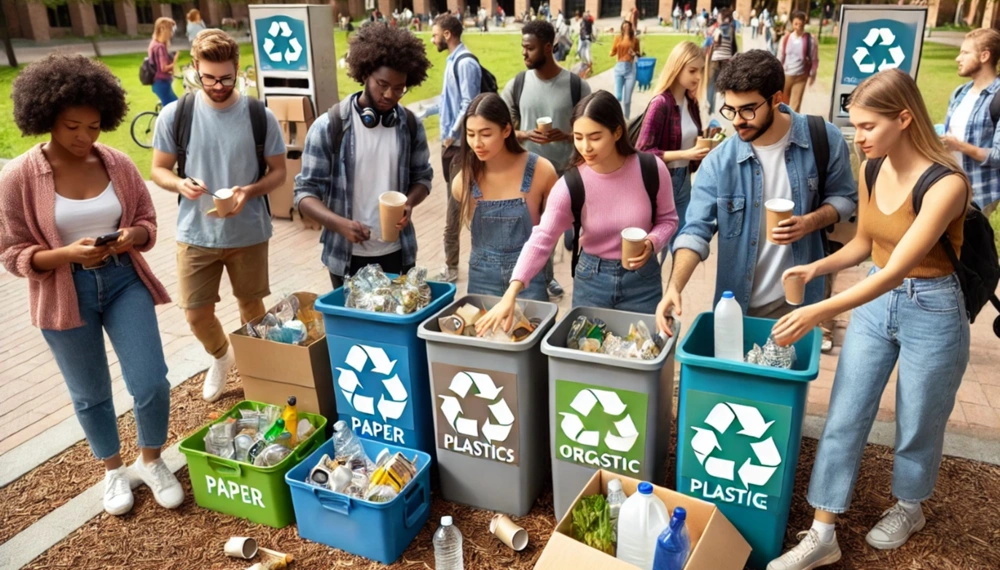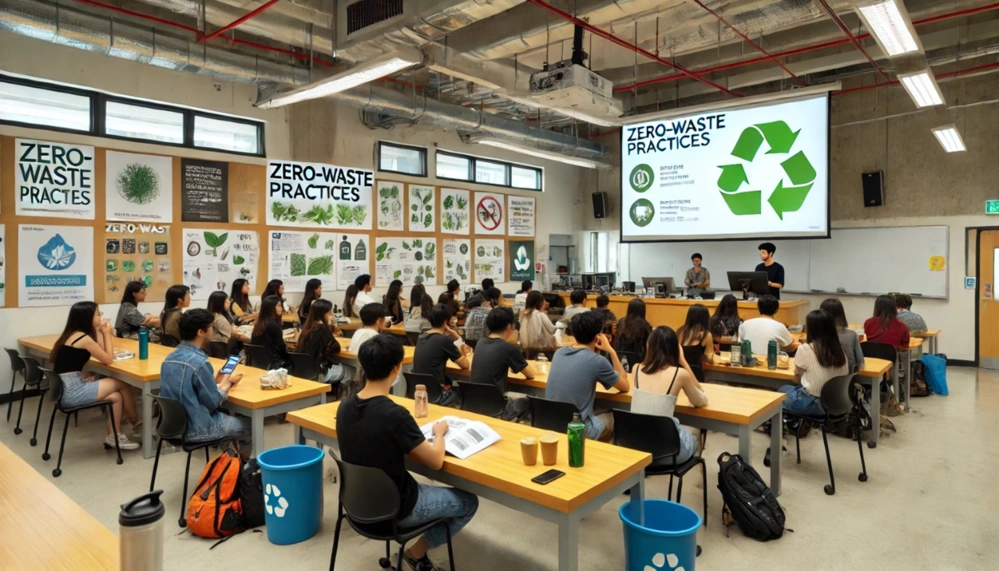Designing a Zero Waste Campus

Knowledge
- Principles of the circular economy and its application in zero waste practices.
- Waste reduction strategies and recycling programs.
- Key components and benefits of implementing zero waste initiatives on a campus.
Skills
- Identify the key components and benefits of implementing zero waste initiatives on a campus.
- Develop and propose effective waste reduction and recycling strategies.
- Design and implement community engagement initiatives to promote zero waste practices.
- Evaluate and monitor the effectiveness of zero waste programs through data analysis and reporting.
Responsibility & Autonomy
- Take responsibility for developing and implementing practical zero waste initiatives on campus.
- Engaging with the campus community and encouraging participation in sustainability efforts.
- Lead by example, advocating for sustainable practices and inspiring others to participate in zero waste initiatives.
Welcome to the "Designing a Zero Waste Campus" WebQuest!
In this journey, you will explore the concept of the circular economy and develop a strategy for the application of zero waste approach at your campus. The world is now moving towards sustainable solutions to address environmental challenges, and this makes the institutions of learning to have a critical responsibility. By adopting zero waste practices, campuses can reduce their environmental footprint, embrace environmental-friendly practices, and foster a culture of responsibility among students and other members. Many universities around the world are already pursuing such a goal, together with other initiatives, to help them become greener and more progressive.
In this WebQuest, you will explore waste reduction measures, recycling activities, and community involvement activities. Your objective is to come up with a viable plan that will be put into practice in your campus in order to enhance the green environment.
Imagine you are part of a Sustainability Committee charged with the task of transitioning your campus to a zero-waste environment. Your assignment is to research and develop a comprehensive zero waste plan that includes:
- Waste reduction strategies to reduce waste generation to a minimum.
- Recycling programs to effectively manage waste.
- Community engagement initiatives to foster and support zero waste practices.
You will outline your findings and suggestions in a detailed report that will describe your plan and demonstrate how it can be implemented at your campus.
Follow these steps to develop a comprehensive zero waste plan for your campus:
Step 1: Conduct a Research on Zero Waste Principles and Circular Economy Models
It is important to understand the key concepts and benefits of these approaches.
- Use academic databases like Google Scholar and ResearchGate to find research papers and articles on the circular economy and zero waste.
- Explore websites of organizations focused on sustainability, such as the Ellen MacArthur Foundation and Zero Waste International Alliance.
- Review case studies of other campuses or organisations that have successfully implemented zero waste programs.
Step 2: Assess Current Waste Management Practices on Campus
- Find out the Waste Management Practices currently applied on your campus and evaluate them. Identify areas where waste is generated and how it is managed. Collect waste samples from these locations over a set period (e.g., one week). Sort the waste into categories such as paper, plastics, organic waste, metals, and non-recyclables. Find a way to determine the quantity.
- Waste in dormitories
- Waste in Cafeterias
- Waste in Classrooms
- Waste in Staff offices
- You can interview facility managers and staff to understand existing waste management practices and challenges.
- Develop a list of questions to ask facility managers and staff. Topics could include current waste disposal methods, recycling programs, composting efforts, challenges faced, and any existing sustainability initiatives.
- Use the information gathered to understand what is working well and where there are opportunities for improvement.
- Gather information from students and faculty.
- Create a survey with questions about recycling habits, awareness of waste reduction practices, willingness to participate in zero waste initiatives.
- Collect and analyse the survey responses to gauge the level of awareness and engagement among the campus community.
- Evaluate existing policies and procedures related to waste management.
- Compare your campus’s policies with best practices from other institutions or recommendations from sustainability organisations.
Step 3: Based on your research and assessment, develop strategies to reduce waste generation on campus.
- Identify sources of waste and propose methods to eliminate or reduce these sources. Review the data collected during the waste audits to identify the main categories and locations of waste generation.
- Propose changes in procurement policies to prioritize sustainable and reusable products.
- Identify and eliminate single-use plastics on campus by promoting reusable alternatives.
- Encourage digital documentation and communication to reduce paper use.
- Establish composting stations for organic waste such as food scraps from cafeterias
- …
- Promote Reuse and Upcycling
- Organize campus-wide events where students and staff can exchange items they no longer need
- Implement a program for the reuse of furniture and equipment within the campus community
- …
- Develop guidelines that prioritize the purchase of sustainable, durable, and recyclable products.
- Establish partnerships with vendors who offer eco-friendly products and services.
Step 4: Design Effective Recycling Programs
- Identify recyclable materials commonly found on campus and determine appropriate recycling methods for each.
- Design clear and accessible recycling stations with proper signage and instructions.
- Develop partnerships with local recycling facilities and organisations to ensure proper waste processing.
Step 5: Organise Community Engagement Initiatives
- Organise educational campaigns and workshops to raise awareness about zero waste practices.
- Set up motivational programmes to encourage participation in waste reduction and recycling initiatives.
- Create a communication plan for all campus members (students, faculty, other stakeholders and other staff) with strategies on how to keep the community informed and involved.
Step 6: Create a measurable plan
- Set clear goals and metrics to measure the success of your zero-waste plan, e.g., reduction in waste volume.
- Set a plan for regular waste audits to gather data on program performance.
- Include recommendations for adjustments based on feedback and data analysis.
- CirculaR Economy strategy FRAMEwork for sustainable SMEs, CIRCULAR ECONOMY EXPERTS COURSE
- What is a circular economy? - Ellen MacArthur Foundation
- Circular economy - European Commission - Environment
- The circular economy in detail - Ellen MacArthur Foundation
- Driving the circular economy on a university campus
- Implementation of a circular economy at universities
- Eight Ways To Reduce Waste
- Strategies for Reducing Waste Generation - Easy4Pro
- 7 Steps to Develop an Effective Recycling Program
- Implement Recycling Program
- Best Practices for Community Recycling Programs
- How to Write an Effective Communication Plan [2024]
- The Recycling Partnership: Solving for Circularity
- Eco-Friendly Business Practices: A Local Recycling Guide
Congratulations on completing the "Designing a Zero Waste Campus" WebQuest! Through this journey, you have gained valuable knowledge about the principles of the circular economy and the application of zero waste practices. You have learned how to assess current waste management systems, develop waste reduction strategies, design effective recycling programs, and engage the community in sustainability efforts. You have also created a comprehensive zero waste plan that can significantly reduce your campus's environmental footprint and promote a culture of sustainability among students and staff.
Continue to advocate for sustainability and inspire others to join the movement towards a circular economy.
- The Concept of Zero Waste in the Context of Supporting Environmental Protection by Consumers, Małgorzata Bogusz, Renata Matysik-Pejas, Andrzej Krasnodębski, Paweł Dziekański, Paper
- Beyond the hacks: Principles for Waste Free Living, Video
- Five Circular Economy Business Models, Video
- Business models and supply chains for the circular economy, Martin Geissdoerfer, Sandra Naomi Morioka, Marly Monteiro de Carvalho, Steve Evans, Paper
- Crafting an Effective Waste Management Plan, Online article
- Approach to assess the performance of waste management systems towards a circular economy: waste management system development stage concept (WMS-DSC), Alessio Campitelli, Jan Kannengießer, Liselotte Schebek, Paper
- Getting to Zero Waste at Concordia, Video
- Ten Ways to Reduce Waste on Campus, Online article
- How To Improve Waste Management In Schools Effectively?, Online article
- National Zero Waste Council - Toolkits and Resources, Website
- National Zero Waste Council, Website
- Sustainable Materials Management | US EPA, Website

Zero Waste Scotland: University of Edinburgh
The University of Edinburgh, in collaboration with Zero Waste Scotland, has implemented a comprehensive zero waste initiative that serves as an exemplary model of the circular economy. This initiative incorporates waste reduction strategies, recycling programs, and community engagement to minimise the university's environmental impact.
- The University has successfully reduced single-use plastics by implementing policies that promote reusable alternatives, such as refillable water bottles and coffee cups. They have installed water refill stations across campus and offer motives for using reusable containers.
- The University has minimised its paper use. They promote digital documentation and communication, such as electronic submissions for assignments and administrative documents.
- The University has set up easily accessible recycling stations with proper signs and directions throughout the campus.
- They launched the Reuseit campaign, which encourages students and staff to donate unwanted items at the end of the academic year, such as clothing, electronics and furniture, to be sorted and made available for reuse in the community.
- They organise regular workshops and seminars are organized to educate the campus community about zero waste practices and the benefits of a circular economy.
- They conduct regular waste audits to assess the effectiveness of waste reduction and recycling programs.
- The University publishes annual sustainability reports detailing its waste management performance, challenges, and achievements.
Links:
Zero Waste Scotland
Sustainability | The University of Edinburgh

